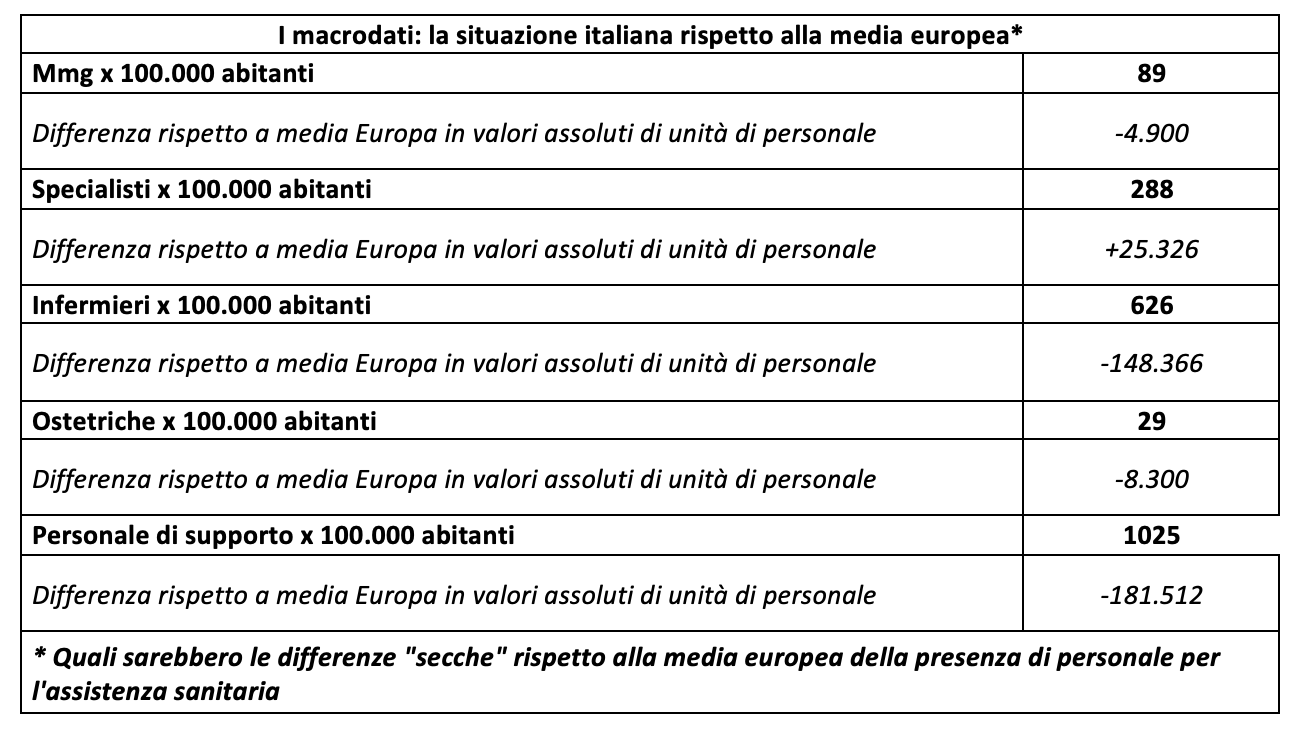From family doctors to nurses, here are all the staff shortages that risk derailing the Pnrr and causing the NHS to collapse. OECD numbers

In addition to the economic resources to guarantee services, there is a shortage of doctors and nurses and, in general, a shortage of all social and health workers who must take care of the revitalization of the territory, but also the rebalancing of hospital services, starting with the emergency rooms. Here is a Eurostat analysis of OECD data showing Italy’s gap with other EU countries.

Jan 22 –
The personnel problem is the first piece of the puzzle that comes together to see what implementation of PNRR isAlert launched by regions: In addition to the economic resources to guarantee services, there is a shortage of doctors and nurses and, in general, a shortage of all social and health workers who must take care of the revitalization of the territory, but also the rebalancing of hospital services starting with the emergency rooms.
Analysis of the Italian situation in relation to the European panorama (not only in the EU countries and in any case also in comparison – for the doctor and nurse professions for which data are available in the OECD Health at a Glance 2022 report – with the G7 partners as more countries industrialized and, therefore, with greater potential for development, also from a technological point of view, as the PNRR itself points out in several of its “missions”) emerges from the focus on Eurostat of the European Union, conducted recently, also in light of the latest data provided by the edition 2022 from OECD’s Health at a Glance.
Besides general data and those referring to economic differences in relation to doctors and nurses, It has been explained previouslyEurostat compares the situation of the workforce of the different European systems of professions and auxiliary activities and allows us to obtain a general picture of what it considers the main professions to be kept “in check”, both from the point of view of distribution compared to the population and on the basis of the functions performed: doctors, nurses and midwives, for the first time , assistance support staff (considering in this chapter both operators such as Italian social and health workers, and home caregivers also not adequately trained in healthcare, but in any case supporting the most vulnerable in carrying out daily activities).
Moreover, Eurostat focuses not only on the situation of the workforce, but also analyzes possible future developments based on the training of the professional figures considered, believing that training is one of the main pillars to gradually fill in the gaps and, in any case, to rebalance care-based jobs Developing skills and specializations.
As far as Italy is concerned, the general picture that emerges is the one that has been emphasized over and over again, of a country in which there is no shortage of doctors, but some numbers and specialties are unavailable. But if today it appears that it is not deficient on paper, we know very well that public health is instead suffering from an acute deficiency. And another disturbing figure, Italian doctors are the oldest in Europe. On the other hand, there are very critical figures with regard to the number of nursing staff whose number is a “reserve” for consistency, and more seriously for future prospects, for training and possible adaptation to the rest of Europe (but also to many OECD countries) than Responsibilities and terms of reference.
It is clear that deficiency numbers cannot be deduced from comparisons between countries, because the structure of different health systems is different and therefore the needs are different, as also indicated by Eurostat. No one can say, for example, that there are “too many doctors” in Italy because their ratio per thousand inhabitants is higher than international averages, and also because, as Eurostat points out, there are sectors in which this type of comparison is of great importance. Weaknesses compared to other countries.
For example, general medicine, where Italy is not completely lacking, but has lost about 5,000 doctors in ten years, those who should theoretically recover to bring the number of Italian doctors per 100,000 inhabitants to the European average. Incumbents often fail to manage their role as a candidate for the region due to the lack of a multidisciplinary organization to assist.
Or even, as Eurostat points out, the balance of certain disciplines (the Eurostat analysis takes into account those on average in the largest number of countries in a similar way) in relation to emerging diseases or therapeutic needs.
Just as it cannot be stated that there would be a shortage similar to that which would arise, for example, for nurses, if their ratio per 100,000 inhabitants were raised to the values of the OECD averages: about 150,000 more than now would be needed and not the 65,000 which Also referred to by the Board of Auditors in its last brief on NADEF (October 2022) and the Italian National Federation of Nurses recognizing in this sense the impossibility of finding such a workforce in any short time, proposed a different organization to help, focusing on a greater responsibility of its professionals towards the chain of care Social and health (regarding the training and management of support operators in structures and also the training of home caregivers, analyzed by Eurostat in the chapter on “support staff”), with the development of roles and responsibilities that Eurostat also indicates in the prof. description of the nursing job in analyzed countries.
And for midwives, another example: the Eurostat data show a shortage in Italy of about 8,300 units, but also in this case the structure of services, the demographic trend (with a sharp decline in births), the epidemiological trend (with the emergence of some perinatal diseases) the increase that may need to continuous support and monitoring) and the organization of multidisciplinary care.
But the consistency based on the relationship with the population is in any case an indicator of the response capacity of the services and the possibility that they evolve, as the PNRR points out, above all towards helping the person in the home.
Julius Nessi
January 22, 2023
© Reproduction Reserved
More articles in Studies and analysis







“Food expert. Unapologetic bacon maven. Beer enthusiast. Pop cultureaholic. General travel scholar. Total internet buff.”




